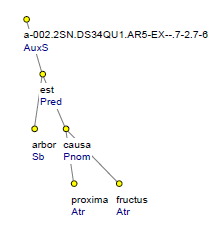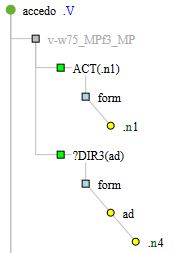
'arbor est causa proxima fructus'
Latin Valency Lexicon (VALLEX)

The Latin valency lexicon (called VALLEX) has been built in close connection with the semantic/pragmatic annotation of the Index Thomisticus Treebank and the Latin Dependency Treebank.
VALLEX contains around 2,500 valency frames for more than 1,000 lexical entries. All the occurrences of the valency-capable words appearing in the syntactically annotated portion of the treebanks are linked to the appropriate valency frame in VALLEX with additional information about its surface morphosyntactic form. For balance and representativeness purposes, VALLEX contains also around 300 lexical entries built in intuition-based fashion selected from the most frequent lemmas reported by Delatte et alii (1981). Dictionnaire Frequentiel et index inverse de la langue latine . Université de Liège: Laboratoire d'analyse statistique des langues anciennes.
The structure of the lexicon resembles that of the valency lexicon for Czech PDT-Vallex. On the topmost level, the lexicon is divided into word entries. A word entry consists of a non-empty sequence of frame entries relevant for the lemma in question, where each different frame entry usually corresponds to one of the lemma's senses. Each frame entry contains a description of the valency frame itself and of the frame attributes. A valency frame is a sequence of frame slots. Each frame slot corresponds to one complementation of the given lemma. The surface morphological features of the frame slots are recorded. Attributes are semantic roles ('functors' in FGD) used to express types of relations between lemmas and their complementations. The semantic roles reported in the frame entries of LV are those for arguments ('inner participants'), while those for adjuncts ('free modifications') are left out. The set of semantic roles is the one provided in the guidelines for semantic/pragmatic annotation of the Prague Dependency Treebank. The Latin Valency Lexicon can be browsed here through the PML-TQ web interface.